

|
|
|


|
Team Associated RC10 EvolutionIntroduction:
Designed and developed by Roger Curtis and released by Team Associated in 1984, the 2WD RC10 series have been arguably the most successful RC Buggy series of all time, winning a numerous ROAR National and IFMAR World Championships.
▼ Scroll Down for More Images ▼
|
1984 RC10
The RC10 self assembly model is gear driven, based on a formed heat treated aircraft alloy chassis tub, with matching bolt on nose plate and motor mount, coil spring over oil filled dampers, a ball differential, front anti roll bar, dogbone drive-shafts, servo-saver, pneumatic tires and either oilite bushings or a full set of 16 ball bearings.
Model Versions:
Features:
In addition, some kits include all or part of the following:
(Source: RC10 April 1989 Catalog) |
"Edinger" and "Cadillac" versions:
In 1984, after a riggerous period of design and development by Roger Curtis and Gene Husting, the first RC10 model kits were manufactured and packaged in a small building at 1928 East Edinger Ave, Santa Ana, California. As success in National and International events and sales increased, in 1986 Team Associated moved to more spacious premises at 3585 Cadillac Ave in Costa Mesa California.
Edinger:
The first two years of production were at the Edinger address. Besides the address printed on the box, the Edinger RC10 box can be recognised by the distinctive "Made in America" sticker at the bottom right of the lid.
|
Cadillac:
From 1986 all RC10 kits were produced at the Cadillac address. Other than the Cadillac Ave address on the box, it can be recognised by the "6 World Championships" impression imprinted at the bottom right of the lid.
|
Early Cadillac:
When Associated first started using the Cadillac addressd boxes, the early batches were sent out with the "Made in America" sticker alongside the "6 World Championships" impression on the lid. When these stickers were all used, all following batches were sent out without.
|
RC10 Chassis Stamp Marks:
If you don't have the original box to help identify your model version, the best place to start is with the RC10 chassis "Stamp" mark. First Generation models did not have a mark, but later versions had a letter stamped on the chassis. "A" was initially stamped on the underside of the Edinger chassis for a short time (rare), then moved the stamp to the inside (see image below). "A" was supposed to be for the original Gold RC10 and CE models, but were found on Black RC10 Team Car chassis with extra holes (see 1990 RC10 Team Car page listed below), "AB" was a kind of transitional chassis, of chassis that had been originally drilled an stamped as "A" then re-drilled for the Stealth Gearbox than stamped with a "B" alongside the "A". "B" stamped chassis were found in the later RC10-CE kits, but were actually for the Stealth Gearbox RC10 Team Cars, and "C" for the Worlds and Championship Edition.
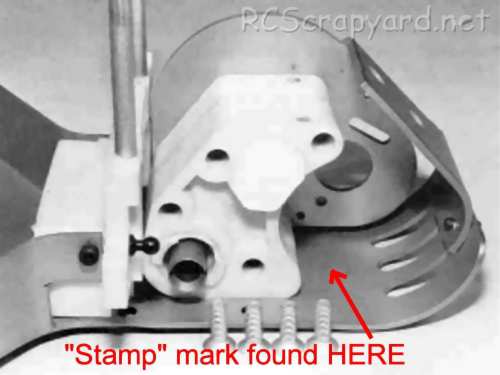
|
RC10 Shocks:
The chassis pictures on the original box are actually of an RC10 Prototype, and some of the more obvious changes made to the parts that came in the kits are the shock absorbers, rear shock mount and no rear anti-roll bar.
|
RC10 Tires:
Over the early years of the RC10, a number of different tires were provided in the kits, and can be another way to help identify your model version.
★ RC10 Good Year Front Tires ★
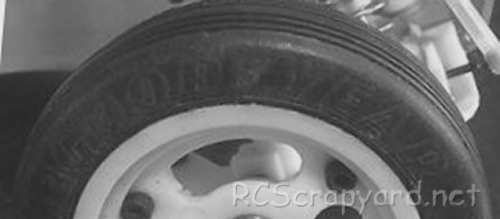
★ RC10 Front 7-Rib Tires ★
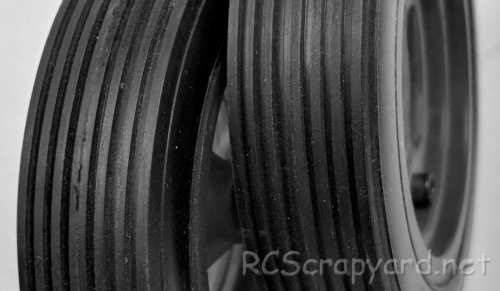
★ RC10 Good Year Rear Tires ★
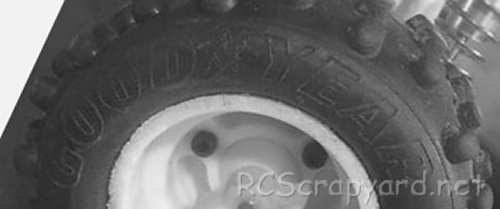
★ RC10 Rear Tires - Associated #6815 ★
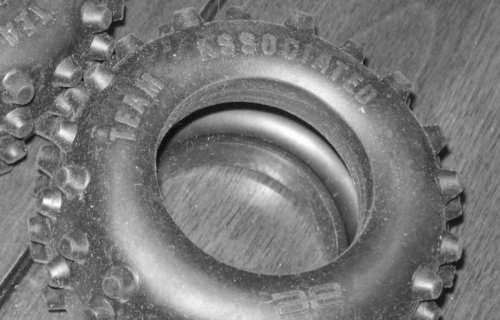
★ RC10 Rear Tires - Associated #6818 ★
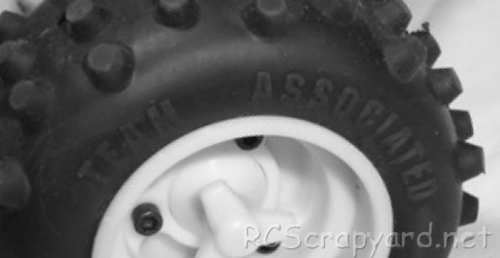
★ RC10 Front 4-Rib Tires - Associated #6868 ★
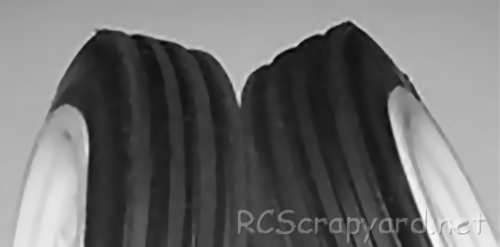
★ RC10 Tires #6868 Sidewall ★
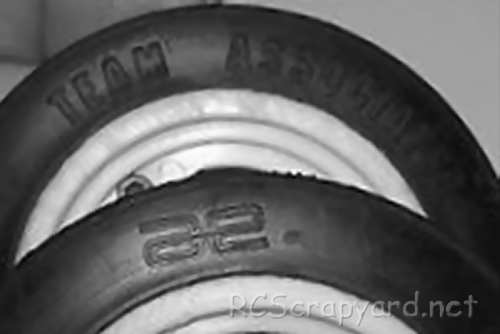

★ Team Associated RC10 Prototype Chassis ★
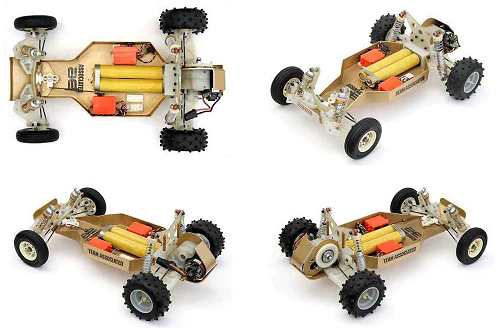
★ Team Associated RC10 ★
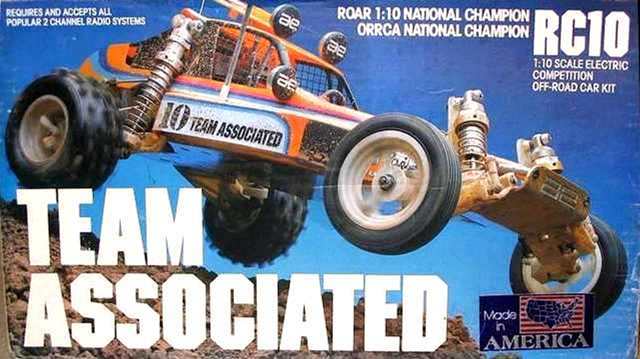
|








|
|
Manufacturers and Brands Catalogued, Listed and Reviewed by RC-Scrapyard.
At present, the RC Model Manufacturers, Brands and Distributors covered by us are: ABC Hobby, Academy, Acme Racing, Agama Racing, Amewi, Ansmann Racing, ARRMA, Team Associated, Atomic RC, Axial, AYK, Bolink, BSD Racing, Capricorn, Carisma, Carson, Caster Racing, Cen, Corally, Custom Works, Durango, Duratrax, ECX - Electrix, Exceed RC, FG Modellsport, FS-Racing, FTX, Fujimi, Gmade, GS-Racing, Harm, HBX, Helion, Heng Long, Himoto Racing, Hirobo, Hitari, Hobao, Hong-Nor, Hot Bodies, HPI, HSP, Intech, Integy, Jamara, JQ Products, Kawada, Kyosho, Losi, LRP, Maisto, Mardave, Marui, Maverick, MCD Racing, Megatech, Mugen, New Bright, Nichimo, Nikko, Nkok, Ofna, Pro-Pulse, Protech, PTI, RC4WD, Redcat Racing, RJ-Speed, Robitronic, Schumacher, Seben, Serpent, Smartech, Sportwerks, Step-Up, Tamiya, Team-C Racing, Team Magic, Thunder Tiger, Tomy, Top Racing, Traxxas, Trinity, Tyco, Vaterra RC, Venom, VRX Racing, WLToys, X-Factory, Xmods, Xpress, Xray, XTM, Yankee RC, Yokomo, ZD Racing and Zipzaps. |
Information and AdviceElectronic Speed ControllersHistory
ESC were originally developed to be used in conjunction with brushed 27T stock and modified motors in the late 1970s, early 1980s. Compared to modern day Controllers, they were Bulky and heavy, constructed using basic resistors, rheostats, capacitors and transistors, crammed together on a simple circuit board, to provide stepped but smooth acceleration when compared to the old mechanical, servo operated sweeper Speed Controllers. An Electronic Switch to change the direction of current flow was used on some of these early ESC to give reverse operation. Although they were a vast improvement on the old mechanical speedos of the time, they were expensive, jerky to control, and prone to burn out if not carefully looked after. |
|
Hints, Tips and Information Electric Motors for RC ModelsWinds and Turns
Q/ What does 15x2 or 17x3 mean? |
|
RC Models:
|
Radio & Motors: |
Other
Accessories: |